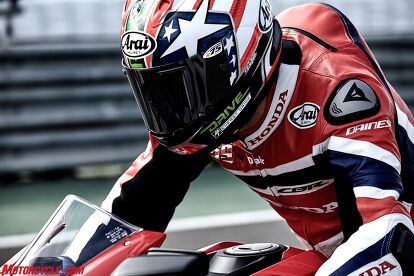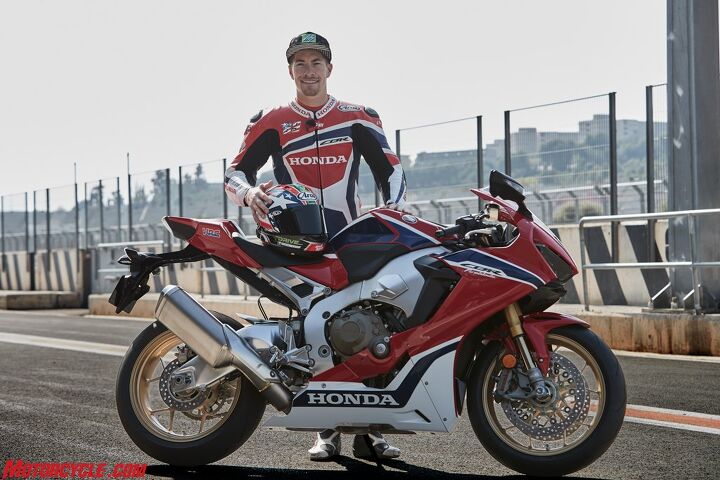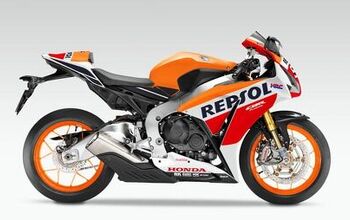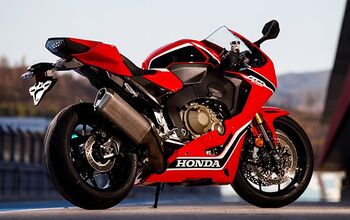2017 Honda CBR1000RR SP and SP2 Unveiling

Honda steps it up and brings two contenders to the literbike war
Just as we suspected, Honda today unveiled its much anticipated 2017 CBR1000RR at Intermot in Germany. We first reported on the new CBR last month as spy photos started to come out, but Honda still had a few surprises in store with this announcement. Two, actually. First, Honda decided to release its up-spec model, the CBR1000RR SP, ahead of the standard edition (Honda says to expect an announcement on that one come November). And second, there would be a second, limited-edition model, the CBR1000RR SP2, homologated strictly for racing purposes (more on that later).
We’ve been waiting a long time for an updated 1000RR to come out, and during that time it would seem Honda heard all of our cries, as the new CBR1000RR SP is loaded with the features we’ve been clamoring for. With a design focus centered on “Total Control” – the same words spoken by Baba-san, the Large Project Leader during the press unveiling of the CBR900RR back in 1991 – Honda had three objectives to meet with the new Fireblade:
- Reduce weight/concentrate mass
- Increase power
- Incorporate the latest electronics
Incorporating the latest electronic rider aids and safety equipment is a relatively recent phenomena, necessitated by the outrageous power today’s liter-class sportbikes are putting out. But the first two objectives have always been the emphasis for sportbike designers, yet as time marches on and global regulations change, sometimes vehicles have to put on some pounds in order to comply. The tightest set of regulations to date take effect on January 1, 2017, when Euro 4 standards kick in, but still, Honda has met the challenge with the new ‘Blade, claiming it to be a whole 33 lbs lighter than the current (Euro spec) SP model while pumping out 10 more horses with 68% new parts.
If this weight claim holds true, then expect the new CBR to weigh around 430 lbs, fully fueled, which would undercut all of its Japanese and German rivals. For comparison, the Euro-spec Yamaha R1 is claimed at 438.7 lbs, Kawasaki’s ZX-10R is 454.2 lbs, Suzuki’s 2016 GSX-R1000 is 451.9 lbs, and BMW’s is S1000RR 449.7 lbs. Only the Ducati 1299 Panigale weighs less, at 420 lbs. In all, the new bike has a 14% better power-to-weight ratio compared to the outgoing model. So, let’s dive into the specifics.
Chassis
We start with the chassis because, as I noted in the spy photo story linked above, the frame looked very similar, if not identical to, the current model. That was done intentionally by Honda, as the current CBR1000RR was praised for its chassis, both by racers and publications worldwide, including MO. In keeping with the Total Control design ethos, Honda decided against reinventing the wheel, essentially taking the old ‘Blade’s chassis and reincorporating it for this new model. However, that’s not the whole story. Portions of the frame walls were thinned down, resulting in 300 grams of shed weight and different chassis flex characteristics to give the rider better feel – and control – especially at the limit.
The die-cast aluminum subframe was overhauled as well, losing 600 grams. Meanwhile, swingarm section thickness was also adjusted, resulting in increased torsional rigidity while losing another 300 grams. Wheels, too, haven’t been overlooked; the six-spoke design of yore giving way to a five-spoke design on the new bike (each spoke then splits into two at each tip, so you could argue it’s a 10-spoke design). Weight drops 100 grams, aided in part to the aluminum spacers also used on the new bike.
Styling is generally a subjective issue, and while I think the new bike looks great (especially in person), objectively the new skin is both slimmer and lighter than before. Honda’s focus in the styling department was for a more aggressive, yet minimalist design. Hence, more of the engine components are visible when viewing the bike from a side profile. The front of the upper fairing is now 24mm narrower than before, while the front of the middle fairing is 18mm slimmer.
The big news in the quest for weight savings is the use of a titanium fuel tank – the first time this has been done in a mass-produced motorcycle. Honda says the new tank is now 2.87 lbs lighter than before and is 30mm narrower at the seat/tank junction.
Honda emphasized the importance of the rider being in control, and how these improvements will help achieve that goal (ironic, considering Honda’s MotoGP efforts have placed engineers over rider input, but that’s beside the point). According to Honda, with the new chassis, yaw and roll moments of inertia have been reduced 15% and 10%, respectively.
Electronics
The outgoing CBR was criticized for its lack of sensors and electrons, but that ends with the 2017 model. Inspired by technology seen on the RC213V-S, the new CBR1000RR SP is now littered with sensors, anchored by the five-axis IMU. First up on the list of electronic components is the semi-active Ohlins Electronic Control suspension – the first time semi-active suspension has been incorporated into a Honda production motorcycle. A 43mm NIX 30 EC fork is mated to a TTX 36 EC shock, and their signals are sent to the suspension control unit located just under the passenger seat section.
Finally, the new CBR utilizes ride-by-wire, a first for a Honda inline-Four. This is necessary to incorporate the numerous aids facilitated by the IMU. Honda Selectable Torque Control (HSTC) is Honda speak for traction-control, and the nine-level system (plus off) is derived from the RC213V-S. Like most contemporary systems seen in competitor models, the Honda’s traction-control system utilizes inputs from the wheel-speed sensors and IMU to determine slip rate and lean angle, using technology, boasts Honda, first developed for the ASIMO robot.
Depending on the level the HSTC is set to, when slip is detected, the software can react and have the bike totally eliminate any wheelspin, or it can electronically maintain throttle to allow a bit of spin before cutting in (regardless if the rider’s right hand is asking for more throttle). As always, the system isn’t a guarantee against highsiding, but it has been developed with lap times in mind, as a little bit of spin is sometimes necessary to finish a corner.
With the addition of HSTC comes wheelie control and engine-brake control. The former also uses the IMU to predict and mitigate wheelies per the rider’s settings. Like the HSTC, when a wheelie is detected via the wheel-speed sensors, the ECU can command the throttle valve to limit power and bring the front tire back down. The latter is adjustable to three different settings to suit rider preference.
More adjustability comes in the form of five-way adjustable riding modes, the first three modes suited to “fast riding”, “fun riding,” and “comfortable riding,” with power, traction control, engine brake control, and electronic suspension settings set accordingly. The last two modes are able to be customized by the rider. To add a little confusion to the mix, the power modes are also adjustable to five different settings within these five riding modes; level 1 providing max power, with power output going down incrementally to level 5. Ride modes, HSTC, and suspension settings are all adjustable on-the-fly.
ABS is another feature of the CBR1000 SP, and this time, it’s linked to the IMU, giving the CBR rear-lift mitigation and, more importantly, lean-angle-sensitive braking, a.k.a. Cornering ABS. Unlike other Honda models, ABS is not linked on the CBR, and the rear ABS can be deactivated if the rider desires.
A technology we wish more bikes came with, the new CBR gets a quickshifter, usable and adjustable in both directions with an auto-blip downshifting feature. The BMW S1000RR and Ducati 1299 Panigale already come so equipped, but it makes Honda the first of the Japanese sportbikes to come so equipped, stock. (Of course, Suzuki has made a liar out of me with the announcement that the 2017 GSX-R1000 will also be so equipped. -TS)
Providing all the information to the rider is a full-color TFT display (another first for Honda) that’s 50 grams lighter than the display unit on the 2016 model. It’s switchable between three displays: Street, Circuit, and Mechanic, the latter providing a whole host of information on the performance of both man and machine. This includes things like maximum lean angle achieved and a scroll of lap times per session, among its many other features.
Engine
It’s a sign of the times that the engine bay is the last stop in our tour of the new CBR1000RR SP. Liter-class sportbikes make more power than us mere mortals know what to do with anyway. Effectively putting that power to the ground is much more important, but nonetheless, if there’s a way to squeeze out more power, Honda engineers were going to find it. Bore and stroke remain the same as before (76mm x 55mm), and the majority of the internals remain the same, too. The 10-hp increase was achieved with relatively simple methods. First, compression ratio is bumped to 13.0:1 from 12.3:1, while piston rings receive a Diamond Like Carbon coating. Camshafts haven’t changed, but both intake and exhaust timing have been optimized for the CBR’s increased rev ceiling – up to 13,000 rpm from 12,250 rpm.
The CBR gets a new airbox and air-intake duct, and the throttle body is now 48mm, up 2mm from before. Fuel discharge pressure is up 14% to promote better fuel atomization and optimize combustion efficiency. That’s really it when it comes to power adders on the latest CBR. The rest of the updates center around weight reduction, as Honda claims the new engine is 4.4 lbs lighter than its predecessor. Clutch cover is aluminum, while ignition cover – and oil pan! – is now magnesium. Both the pressure plate and clutch cams within the slip-assist clutch are now die-cast aluminum, also for weight savings.
While not an internal engine component, the new ‘Blade’s radiator is 30mm narrower than before, reducing its projected frontal area and its weight by 100 grams compared to before. Despite the reduced area, an updated high-density core allows the radiator to achieve the same level of heat dissipation as the outgoing model. Lighter hoses and clamps also contribute to the weight reduction. Continuing with the weight-loss theme, the exhaust canister is now titanium, resulting in 6.17 pounds shed compared to the previous bike and an improved concentration of mass.
Pricing has not been set yet, but Honda America estimates the 2017 CBR1000RR SP will be under $20,000.
SP2
If you’re wondering whether Honda is serious about going racing again (contrary to belief, the Ten Kate World Superbike team Nicky Hayden rides for is not a factory effort), the SP2 should put those worries to rest. A homologated version of the SP – U.S. reps predict a limited production run of 500 units globally to be built over the next two years – the CBR1000RR SP2 receives 1mm larger intake valves, 1.5mm larger exhaust valves, and a change in included valve angle to 10º on the intake side and 12º on the exhaust, versus 11º on both sides for the standard SP model. Forged aluminum Marchesini wheels are also part of the deal.
Honda reps were tight-lipped about what’s to come but stated the revisions to the cylinder head to receive the bigger valves and the updated included valve angles were part of a bigger plan to incorporate a suite of HRC parts.
Now the bad news: the SP2 will be difficult to get to begin with, and Honda reps stated the HRC parts won’t be something the average racer can simply purchase from their dealer. The parts will be reserved for professional racing teams, with Honda/HRC determining who will get access to them. Simply put, if your name isn’t Nicky Hayden, you’re probably out of luck.
As for the good news: the CBR1000RR SP2 is estimated to cost less than $25,000.
Standard Model
For those wanting a standard version of the CBR1000RR, Honda will make an announcement come November regarding its availability. Those with keen eyes will have noticed from the spy shots linked to at the beginning of the article that the model seen in those photos is void of the Ohlins suspenders and Brembo brakes of the SP model. If history is any indicator, Showa will provide suspension on the base model, with Nissin brakes. American Honda reps didn’t provide any information on the standard model, including pricing information, but expect it to be priced competitively with its rivals.
Honda says we’ll get to ride the new CBR1000RR SP around March 2017. Stay tuned for our riding impressions then.

Troy's been riding motorcycles and writing about them since 2006, getting his start at Rider Magazine. From there, he moved to Sport Rider Magazine before finally landing at Motorcycle.com in 2011. A lifelong gearhead who didn't fully immerse himself in motorcycles until his teenage years, Troy's interests have always been in technology, performance, and going fast. Naturally, racing was the perfect avenue to combine all three. Troy has been racing nearly as long as he's been riding and has competed at the AMA national level. He's also won multiple club races throughout the country, culminating in a Utah Sport Bike Association championship in 2011. He has been invited as a guest instructor for the Yamaha Champions Riding School, and when he's not out riding, he's either wrenching on bikes or watching MotoGP.
More by Troy Siahaan




















































































Comments
Join the conversation
Is the pictures distorted,or are that bike seriously narrow?Looks very nice.Wish I was young rich and bold!
Too little too late! People are sick of Honda's reluctance to provide products that are leading edge. People want a VFR1000RR SP/SP2 ! Problem is, people know what Honda is capable of. This rehashed 2004 model is another let down. Oh well, maybe in 2030, when they revamp again?